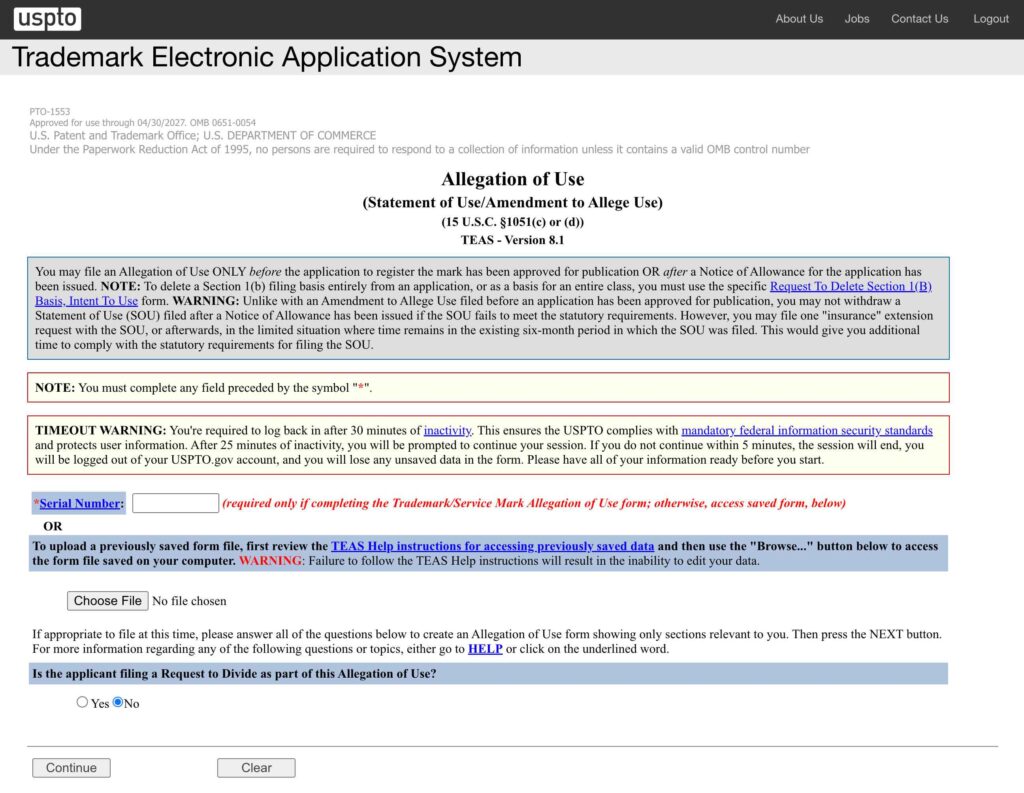In order to register a trademark at the Federal level, you must show proof that you are using your trademark in commerce. In this regard, understanding how, when and why you must file a statement of use in connection with your trademark application is crucial. Filing a Statement of Use confirms that your trademark is actively being used in commerce—a legal requirement for a USPTO registration.
This article provides a practical guide to filing your Statement of Use, focusing on timely submission and compliance with the appropriate USPTO standards.
Key Takeaways regarding the Statement of Use
- The Trademark Statement of Use (SOU) is a document filed with the United States Patent and Trademark Office (USPTO) to demonstrate that a trademark is currently in actual use in commerce – a legal requirement for completing the trademark registration process.
- Applicants have a six-month period from the date of the Notice of Allowance to file the SOU or an extension request. Failure to do so can result in the abandonment of the trademark application.
- Accurate and complete information, including specimens showing the trademark’s use in commerce, is required when filing the SOU. An assortment of common filing errors can lead to delays, additional office actions, or outright rejection of your trademark application.
What is a Trademark Statement of Use?
The Statement of Use (SOU) is a vital part of the trademark process and is often seen as its cornerstone. It is an official legal document that you must file with the USPTO asserting your actual use of the applied-for trademark in commerce. A trademark statement of use is required for trademark applications that are filed on an intent to use basis.
Definition and Purpose of the Statement of Use
Ultimately, a Statement of Use serves as your proclamation to the USPTO that your trademark has moved beyond the concept phase and is now actively being used in the marketplace. Applicants who have filed a 1(b) or an “Intent to Use” trademark application are legally required to file the SOU after they have received a Notice of Allowance.
By filing this document, you are indicating to the USPTO that your trademark has transitioned from a mere intention to use your trademark to actively using your trademark in commerce.
The SOU isn’t just a procedural measure, it’s a significant part of your trademark progression. Filing a Statement of Use serves as tangible proof of your trademark’s actual use. This use is a prerequisite for registering a trademark, proving to the USPTO that your mark was not filed to merely keep others from using your trademark.
Importance for Trademark Protection
The SOU transcends being mere paperwork to become a key element of your trademark protection strategy. It aids in preserving the active status of your trademark and wards off abandonment claims.
More so, a trademark Statement of Use is integral for concluding your trademark application. Assuming you have received a notice of allowance, the USPTO will not issue a registration certificate without this important legal document.
Not using your trademark regularly or in a uniform way could undermine its legal defenses. By filing a Statement of Use on time, you bolster the legal shield surrounding your trademark, ensuring its legal protection in the future.
Preparing to File a Statement of Use
Prior to filing your Statement of Use, a few preparatory steps are necessary. These involve:
- Receiving a Notice of Allowance from the US Patent and trademark office
- Collecting necessary data, including proper specimens showing actual use of your trademark in commerce
- Validating that your application is devoid of common errors which might delay or reject it.
What is a Notice of Allowance and how does it relate to the Statement of Use?
The Notice of Allowance (NOA), issued by the USPTO, marks a significant phase in your trademark progression. It signifies the nearing completion of your trademark registration and the need to ready your Statement of Use for filing.
Once you receive a Notice of Allowance, you have six months from the issuance date on the Notice to submit your Statement of Use. Failing to file a Statement of Use or an extension request within this timeframe can lead to your application being abandoned.
The following is an example of a Notice of Allowance from the USPTO.

Gathering Required Information
Accuracy is critical when submitting a Statement of Use. The information you provide should aptly represent the goods or services linked to your trademark. Any discrepancies can lead to objections or even an “office action” from the examining attorney at the trademark office.
Remember, the USPTO requires that you show proof of the use of your trademark in commerce for each class of goods or services claimed in your application. This involves providing clear and adequate specimens that accurately showcase your trademark as it is used in commerce.
In case your original specimens are rejected, you should be ready to supply alternative specimens used during the initial timeframe set for the Statement of Use filing.
The Filing Process for a Trademark Statement of Use
With all your information and specimens ready, you can proceed to file your Statement of Use. The filing process involves using the Trademark Electronic Application System (TEAS), filling out the Statement of Use form, and submitting it with the relevant filing fees.
Accessing TEAS
The Trademark Electronic Application System (TEAS) is your gateway to filing a Statement of Use. This online platform provided by the USPTO is where you’ll submit your official documents, including the Statement of Use.
Filing your Statement of Use requires accessing the specific TEAS trademark Statement of Use (SOU) form. These forms can be previewed on the USPTO’s form previews page without any need to log in. But bear in mind, when it’s time to file your actual documents, you’ll need to access the TEAS system and log in with your USPTO.gov account.
Click here to download a pdf copy of the Allegation of Use (i.e. Statement of Use) Form
You will also need to enable two-step authentication and verify your identity using id.me before you can access the necessary forms. If this is something that scares you, or causes you trouble, you may want to consider hiring a lawyer to assist with your trademark statement of use.
Completing the Statement of Use Form
While completing the trademark Statement of Use form might appear simple, it’s vital to fill it correctly. Information such as the serial number associated with your trademark application, the class numbers, and a specimen of your trademark as used in commerce need to be provided.

On the first page of the form, you will be asked to enter the Serial Number. If the deadline to respond has passed, you will not be able to access the remainder of the form. If you are still within the 6 month filing period, the remainder of the form will be pre-filed with your information from your application and the Notice of Allowance.
For each class of goods/services on your notice of allowance, you will be asked a series of questions, and you will have to upload a digital image (or images) showing actual use of your trademark in commerce. If you are uploading screenshots from a website, you must include the URL of the page as well as the date that you accessed the page. You must also include the date that you first began using your trademark as well as the date that you first began using your trademark in commerce.
The owner of the trademark (or a representative of the entity that owns the trademark) must sign a declaration or verified statement that your trademark is currently in use in commerce. While some errors are fixable, such as selecting the wrong trademark class or uploading an incorrect type of specimen, others can lead to delays or rejection. Therefore, it’s important to ensure that your form is accurate and complete before submission. Submitting the wrong party as the owner on your trademark application may void your trademark before you even get out of the gate.
Please note that lying on this form is a Federal crime that could carry many other penalties worse than just losing your trademark. So don't file your trademark Statement of Use unless you are truly using your trademark in commerce!
If you aren't currently using your trademark in commerce, you may file an extension as outlined below.
Submitting the Form and Paying the Fee
Once you’ve completed your Statement of Use form, the last step is to submit it and pay the filing fee.
For electronic filings, the trademark office charges a filing fee of $100.00 per class for a Statement of Use. However, if you opt for mail submissions, the fee rises to $200.00 per class. Payments can be made using a credit card, USPTO deposit account, or Electronic Funds Transfer (EFT).
Finally, remember that when you submit your Statement of Use, you also need to meet the minimum filing requirements:
- Include the required fee
- Provide at least one specimen showing how the mark is used
- Include a sworn verified statement or signed declaration attesting to the use of the trademark in commerce
- Timely file your trademark Statement of Use
Proving Use in Commerce: Specimens and Evidence
Demonstrating use in commerce is an integral aspect of your Statement of Use. Here, you establish to the trademark office that your trademark is being actively used in commerce and isn’t just a marketing concept. This proof often comes in the form of legal specimens and other forms of evidence.
Types of Specimens
Specimens act as your evidence of commercial usage. In the case of goods, a specimen might be a photograph showing your trademark in use on actual products. For services, specimens tend to be different and can range from advertising materials to screenshots of your website.
It is important to understand that you need to provide a specimen for each class of goods or services claimed in your trademark application as reflected in the Notice of Allowance. These specimens must be clear and legible, accurately showing your trademark as used in commerce.
Providing Adequate Evidence
Supplying sufficient evidence of commercial us is a key part of your Statement of Use. As mentioned before, when you file your Statement of Use, you must include the required fees, examples of use for each class, and a sworn statement confirming the mark is actively used in commerce.
When I am collecting specimen evidence for my clients, I try to provide multiple files showing the mark in commerce on multiple products (for goods) or multiple screenshots of my client's website (for services). I don't want to give the examining attorney any reason to doubt that my client is actually using the mark in commerce.
Remember, each class and corresponding product or service listed on the notice of allowance must have at least one specimen showing the mark in use in connection with that product or service. So if you have 5 different products in a single class, you should include proof that your trademark is being used in connection with each of those 5 products.
If the evidence you provide is not acceptable, such as when it is not appropriate for the type of goods or services applied for, or if you have not included adequate proof that your trademark is being used with all of the goods or services listed in the notice of allowance, then you run the risk that your specimen will be rejected.
What if you are only using some of the products or services?
If you are only using some, but not all of the products or services in commerce, then you may want to speak with a trademark attorney about filing a “request to divide”. In doing so, you can divide your trademark application into two separate serial numbers.
By doing so, the goods/services that are currently in use in commerce can proceed to registration, while the rest of your application can be extended until you begin using those respective goods in commerce.
Extension Requests and Deadlines
Sometimes, despite your best efforts, you may need more time to prepare your Statement of Use. In such cases, you have the option of filing an extension request. However, it’s crucial to be aware of the associated deadlines, fees and consequences.
Filing an Extension Request
Should you find yourself unprepared to file your Statement of Use within six months of receiving your Notice of Allowance, there’s no need to worry. Filing an extension request is an available option. This request gives you an additional six months to prepare your Statement of Use.
Bear in mind though, extension requests cannot be filed indefinitely. You can file up to five six-month extensions, affording you a maximum of three years from the issuance of the Notice of Allowance to file your Statement of Use. Each extension must be filed during the previously granted extension period and tacks an additional 6 months to the prior deadline.
Deadlines and Consequences
When applying for a trademark, deadlines should be treated with utmost seriousness. Following the date of your Notice of Allowance, a six-month window is provided to file either your Statement of Use or an extension request. This is a statutory deadline and failing to meet these deadlines can result in your application being considered abandoned, which can be a costly mistake. To avoid this, it is crucial to provide a written notice in a timely manner.
The ultimate deadline to use your trademark commercially and file your Statement of Use is three years from the issuance date of your Notice of Allowance. If you don’t meet this deadline, your trademark application will be abandoned. This means you lose your trademark rights, and your mark becomes available for others to register.
Tips for a Successful Statement of Use Application
Despite the process appearing overwhelming, meticulous preparation and a keen eye for detail can lead to a successful filing of your Statement of Use. Here are some essential tips to steer you on the path to success, from working with a trademark attorney to avoiding common mistakes in the filing process.
Working with a Trademark Attorney
Steering through the intricacies of the trademark process can be tough. This is where the expertise of an experienced trademark attorney proves beneficial. They can guide you through the trademark process from beginning to end, helping to ensure your Statement of Use meets all USPTO requirements and deadlines.
Trademark attorneys offer a range of services, including:
- Conducting trademark clearance searches
- Properly preparing your trademark application
- Managing all legal correspondence from the USPTO
- Providing advice on collecting necessary information
- Identifying legal strategies to overcome office actions
- Preparing accurate descriptions for your Statement of Use
They can provide valuable guidance and support throughout the trademark process.
While hiring a trademark attorney requires additional upfront payments, the investment can vastly improve your chances of successful trademark registration and is one of the best ROI investments you can make in your business.
Common Statement of Use Trademark Mistakes to Avoid
While filing a Statement of Use is a vital step in the trademark registration process, it is also a phase prone to errors by many applicants. I am amazed at how many applications are abandoned by entrepreneurs who attempt to DIY their trademark and receive a rejection for an improper specimen. Submitting incorrect or incomplete information on the Statement of Use can lead to delays, office actions, or even rejection of the application.
Another common mistake is submitting specimens that do not show the trademark as actually used in commerce. For instance, mockups or printer’s proofs are not acceptable. T-shirts with the trademark shown on the front of the shirt will similarly be rejected as “purely ornamental”.
It is also common to see the specimens provided in the statement of use do not match the goods and services listed in the notice of allowance.
Lastly, remember to provide enough evidence to substantiate your use in commerce claim. Without this, the USPTO may question reject your Statement of Use.
Summary
Navigating the pathway to obtaining a registered trademark may seem like a daunting task, but with the right guidance and preparation, it is a journey you can successfully navigate. Remember, your Statement of Use is not just a bureaucratic formality—it’s your declaration to the world that your trademark is more than an idea. It’s a reality, it's actively used in commerce, and it is deserving of the protection only registration can provide.
Frequently Asked Questions regarding a Statement of Use
The following are answers to some frequently asked questions regarding filing a statement of use.
What is a Statement of Use?
A Statement of Use is a document filed with the USPTO to assert active use of a trademark in commerce.
When do I file a Statement of Use?
You must file your statement of use within six months after the date listed on your Notice of Allowance, or within six months after the filing of an extension.
How do I file a Statement of Use?
To file a Statement of Use, you can use the Trademark Electronic Application System (TEAS) provided by the USPTO. You may also mail in a Statement of Use to the USPTO in Arlington, Virginia.
What if I miss the deadline to file a Statement of Use?
If you miss the deadline to file a Statement of Use, your trademark application may be considered abandoned, potentially leading to a loss of your trademark rights.
What is an extension request?
An extension request provides an additional six months to prepare your Statement of Use if you're not ready to file within six months of receiving your Notice of Allowance.
Can I file an extension request indefinitely?
No, you can request up to five six-month extensions, giving you a maximum of three years from the Notice of Allowance to file your Statement of Use.
Are you running into issues with your Statement of Use?
It's ok to ask for help. The trademark process can be complicated. If you received an office action because the examining attorney rejected your specimen, we would love to help. We have helped other entrepreneurs overcome similar rejections and save their trademark.
Simple click here to schedule a strategy call.
Husband, Father, Lawyer, Entrepreneur, YouTuber and Die-Hard Cleveland sports fan. I love helping founders build and protect their intellectual property and brand names with trademarks, copyrights, and contracts. #gobucks



